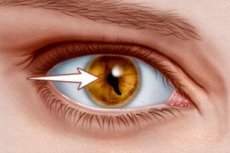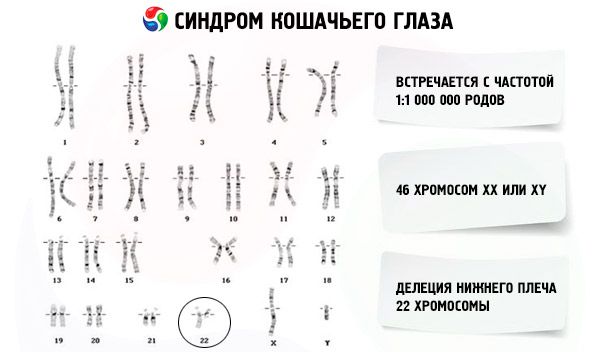Medical expert of the article
New publications
Cat-eye syndrome
Last reviewed: 12.07.2025

All iLive content is medically reviewed or fact checked to ensure as much factual accuracy as possible.
We have strict sourcing guidelines and only link to reputable media sites, academic research institutions and, whenever possible, medically peer reviewed studies. Note that the numbers in parentheses ([1], [2], etc.) are clickable links to these studies.
If you feel that any of our content is inaccurate, out-of-date, or otherwise questionable, please select it and press Ctrl + Enter.

Chromosomal diseases are a large group of genetic hereditary pathologies, which include cat eye syndrome (synonyms: CES, duplication of chromosome 22 (22pt-22q11), partial tetrasomy of chromosome 22 (22pter-22q11), partial trisomy of chromosome 22 (22pter-22q11), Schmid-Fraccaro syndrome). This syndrome is a relatively rare chromosomal disease, which is characterized by two main symptoms: atresia (absence) of the anus and anomaly of the development of the iris, externally resembling a cat's eye.
Epidemiology
The prevalence of this pathology is 1 case per 1,000,000 newborns.
 [ 8 ]
[ 8 ]
Causes cat-eye syndrome
The fundamental role in the development of the disease is given to the hereditary factor: if there is a sick person with cat's eye syndrome in the family, there is a high probability of having a child with a similar pathology.
 [ 9 ]
[ 9 ]
Pathogenesis
The pathogenesis and type of inheritance of the disease are still unknown, since the pathology is sporadic. In some cases, specialists have identified redistribution of the microstructure of chromosome 22 (incomplete trisomy, as a consequence of interstitial duplication 22q11.2), as well as a small additional acrocentric chromosome that appears suddenly due to a failure at the stage of cell division during gametogenesis in the mother or father.
Theoretically, it is assumed that the pathology can be considered hereditary. Based on this theory, the mother or father has genetically different cells, that is, not all cells contain the same chromosomes. Since the acrocentric chromosome is not found in all cells, cat eye syndrome in a given generation may not manifest itself, or be detected in a mild form.

Symptoms cat-eye syndrome
Cat eye syndrome is sometimes called partial tetrasomy 22 or Schmid-Fraccaro syndrome in medical circles. The first signs are noticeable at birth and are characterized by the following symptoms:
- absence of anus, undescended testicles (cryptorchidism), underdevelopment or absence of the uterus, umbilical or inguinal hernias, Hirschsprung's disease, megacolon;
- absence of a section of the iris on one or both sides;
- drooping of the outer corners of the eye slits, slanted eyes, epicanthus, ocular hypertelorism, strabismus, unilateral microphthalmia, absence of the iris (aniridia), coloboma, cataract;
- protrusions or depressions at the anterior surface of the auricles, absence (atresia) of the external auditory canal, conductive hearing loss;
- heart valve defects (tetralogy of Fallot, ventricular septal defect, pulmonary artery stenosis, right ventricular hypertrophy);
- developmental defects of the urinary system, renal failure, unilateral or bilateral renal hypoplasia and/or agenesis, hydronephrosis, cystic dysplasia;
- small stature;
- curvature of the spine, underdevelopment of the skeletal system, scoliosis, abnormal fusion of some bones in the spine (vertebral fusions), radial aplasia, synostosis of certain ribs, hip dislocation, absence of some fingers;
- mental retardation (not always, but in the vast majority of cases);
- underdevelopment of the lower jaw, cleft lip;
- tendency to hernia formation;
- cleft palate;
- other developmental defects such as vascular anomalies, hemivertebrae, etc.
Cat's eye syndrome at death
Cat eye syndrome, as a hereditary disease, is often confused with the so-called effect, or symptom of the "cat pupil" - one of the first and obvious signs of the irreversible process of cell death - biological death of a person. The essence of this effect is that with a slight pressure on both sides of the eyeball of a deceased person, the pupil becomes oval (slightly elongated, like a cat). If the person is alive, the shape of the pupil does not change and remains round: this happens due to the tone of the muscles that hold the pupil, as well as due to the persistent intraocular pressure.
After a person dies, the central nervous system stops working, the muscles relax, and the blood pressure drops due to the cessation of blood flow. As a result, the intraocular pressure drops sharply.
The cat's pupil symptom can be observed as early as 10 minutes after the moment of biological death of the organism.
Complications and consequences
The consequences of the syndrome depend on what congenital anomalies the newborn baby has. The degree of defects, the functionality of organs and systems, and the timeliness of medical care are also important.
No one can say how long a person with cat's eye syndrome will live. If you take care of the baby, support his health with medications, adapt him to the environment, then the prognosis of the disease can be called satisfactory. However, given that the syndrome is often accompanied by multiple developmental defects, the quality and duration of the patient's life can be predicted only after a thorough examination by specialists: cardiologist, urologist, neurologist, surgeon, orthopedist, etc.
Diagnostics cat-eye syndrome
In most cases, the diagnosis is established based on the child's characteristic appearance. For a more accurate diagnosis, cytogenetic analysis and examination of the baby's chromosome set may be prescribed. Such a study is recommended to be carried out even during the period of conception planning, if family members have already had cases of chromosomal abnormalities. If the results are unsatisfactory, the following are additionally prescribed:
- amniocentesis – analysis of amniotic fluid;
- chorionic villus sampling;
- cordocentesis – analysis of the umbilical cord blood of the fetus.
As a rule, patients are found to have an extra chromosome, which consists of a pair of identical sections of chromosome 22. Such a section exists in the genome in four copies.
If the disease is caused by a duplication of the 22q11 region, then three copies are found.
What tests are needed?
Differential diagnosis
Differential diagnosis is carried out with Rieger's syndrome - mesodermal dysgenesis of the cornea and iris.
Who to contact?
Treatment cat-eye syndrome
Children born with cat eye syndrome are subject to mandatory examination by specialized medical specialists. The treatment they prescribe should be aimed at eliminating symptoms and improving the child's quality of life as much as possible. This approach is primarily due to the fact that this chromosomal disease is currently considered incurable.
First of all, surgical treatment may be required to correct the functioning of the digestive and cardiovascular systems.
In addition, a course of medication and psychotherapy may be prescribed to support psychomotor activity. Physical therapy, regular massage sessions and manual therapy will also have a positive effect on the child's condition.
As we have already indicated above, genetic testing of parents before conception is the best prevention of chromosomal abnormalities. If any family member or close relative has been diagnosed with cat eye syndrome, then future parents should carefully prepare for a possible pregnancy and exclude possible fetal developmental abnormalities in advance.

